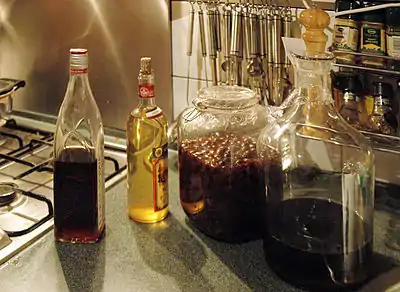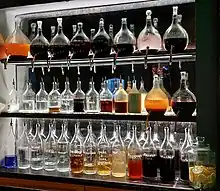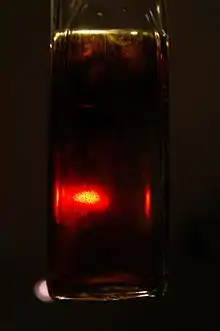
Nalewka (IPA: [na'lɛfka]), plural nalewki, is a traditional alcoholic beverage from Poland.[1] Similar to medicinal tinctures,[2]: 108 it is usually 40% to 45% alcohol by volume, though some can be as strong as 75%.[3] Nalewka is created by macerating and / or infusing various ingredients in alcohol, usually vodka or neutral spirits. Among the ingredients often used are fruits, herbs, spices, roots, sugar and honey. The name nalewka is currently being registered for national appellation within the European Union.[2][4] Unlike ordinary liqueurs, nalewki are usually aged.[4][5] Since nalewka is produced by infusion rather than distillation, the liquid is typically colorful and somewhat opaque. Taste-wise, nalewka is similar to fruit liqueurs such as schnapps or eau-de-vie, but is usually sweeter and typically lacks a strong alcohol taste.
The name nalewka is sometimes misleadingly used for a variety of commercially produced alcohols sold in Poland, usually of low quality and alcohol content.
It could also be confused with its cognate, nalivka or nalyvka (Russian, Ukrainian: наливка), popular in Ukraine since the 17th century and in Russia since the second half of the 16th century.[6][7][8] While the Polish nalewka is an infusion, the Ukrainian/Russian nalivkas are made by filling a jar with fruit, sugar and water, sealing it, and letting the contents ferment. Thus, the Ukrainian/Russian nalivkas are much weaker (usually containing less than 20% alcohol).[9][10] The proper name for a Russian analogue of a Polish nalewka would be nastoika, infusion. (Russian: настойка, Ukrainian: настоянка, nastoyanka, literally, tincture).[11]
History

The first documented alcoholic herbal tinctures were created by Hippocrates, the "father of medicine", as treatments for illnesses. During Roman times it was popular to infuse wines with spices, giving rise to hippocras and mulled wine. Through the following centuries, various European cultures developed many flavored alcohols using locally available fruits, herbs and spices. This was a way to preserve the flavors and medicinal properties of seasonal ingredients for use throughout the year, either as remedies or libations. Creating sweetened alcoholic tinctures gained popularity in Poland during the 16th century, possibly due to an influx of French culture brought by Henry III of France. The oldest known Polish book describing nalewka was written by Stefan Falimierz and published in Kraków in 1534, titled On Herbs and Their Potency (O ziolach y o moczy gich).[12] From the 16th to 19th centuries the Manor houses of Polish nobility would typically produce and stock a variety of nalewki, and the recipes were passed down from generation to generation in home almanacs called "Silva rerum". Families in the Polish nobility, known as the Szlachta, often kept these recipes secret, and they were only given to the senior children upon the death of the father.[2] The production of nalewka later spread to ordinary households, and from the mid to late 19th century a large number of books were published describing processes and recipes, as well as instructions for obtaining ingredients.
Ingredients

Most nalewkas have their proper name derived either from their main ingredient or from the name of their traditional place of production. Common ingredients of nalewkas are fruits, herbs, spices, roots, leaves, flowers, sugar, and honey. Some examples of ingredients and the corresponding nalewka are below:
- Anise (anyżówka)
- Apricots (morelówka)
- Blackberry (jeżynówka)
- Blackcurrants (porzeczkówka)
- Cherries (wiśniówka)
- Chokeberries (aroniówka)
- Common hawthorn (głogówka)
- Cornus mas (dereniówka)
- Ginger (imbirówka)
- Green Persian walnuts (orzechówka)
- Juniper (jałowcówka)1
- Lemon (cytrynówka)
- Quince (pigwówka)
- Raspberry (malinówka)
- Wormwood (piołunówka)
Notes
See also
References
- ↑ Lucyna Ćwierczakiewiczowa (1858). Jedyne praktyczne przepisy... (in Polish). Warsaw, Gebethner i Wolff. p. 264. ISBN 83-7386-071-1.
- 1 2 3 Jan Rogala (2003). Nalewki zdrowotne, czyli 102 przepisy na alkohol który wspomaga organizm (in Polish). Warsaw, Baobab. ISBN 83-89642-00-X.
- 1 2 Grzegorz Russak. "Nalewki staropolskie – chluba przeszłości, nadzieja przyszłości". Polonia.org (in Polish). Krefeld: Polonia Świata. Retrieved 2006-07-10.
- 1 2 Zdzisław T. Nowicki (2002). Domowe piwa, cydry, wina, nalewki, likiery i kremy (in Polish). Gdynia, Galion. p. 324. ISBN 83-909329-3-8.
- ↑ Jan Makosiński (1911). Przepisy do przyrządzania wódek, rozolisów, rumów, araków, likierów, cognaców, esencyi ponczowych, krupników i grogu (in Polish). Kraków-Kielce, Avis. p. 43.
- ↑ Чем наливка отличается от настойки. aif.ru (in Russian). 27 May 2017. Retrieved 2023-04-15.
- ↑ John Frederick Erdmann (1825). "Manners and Customs of the Russians in the Government of Kasan". The cabinet of foreign voyages and travels. London: Treuttel & Würtz. p. 81.
- ↑ "Наливка". Brockhaus and Efron Encyclopedic Dictionary (in Russian). Leipzig-St. Petersburg: Brockhaus and Efron. 1890–1906. Archived from the original on 2014-04-07. Retrieved 2011-01-16.
- ↑ "Наливка". Great Soviet Encyclopedia (in Russian) (III ed.). Moscow. 1969–1978. Retrieved 18 June 2020.
{{cite encyclopedia}}: CS1 maint: location missing publisher (link) - ↑ "Наливка". Российский гуманитарный энциклопедический словарь (in Russian). Vol. 2 (I ed.). St. Petersburg: Гуманитарный издательский центр ВЛАДОС. 2002. ISBN 5-8465-0021-8. Archived from the original on 2012-11-05. Retrieved 2011-01-16.
- ↑ "Настойка". Малый Академический Словарь русского языка (in Russian). Vol. 2 (IV ed.). Moscow: RAS Linguistic Studies Institute, Poligrafresursy. 1999. Retrieved 2011-02-14.
- ↑ Studies in Polish Civilization. Institute on East Central Europe, Columbia University. 1971. p. 347.
External links
- Nalewka Tarninówka Archived 2018-12-26 at the Wayback Machine